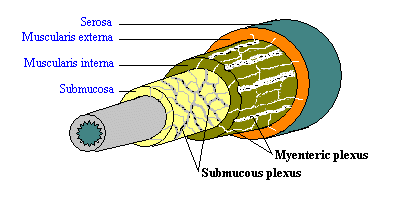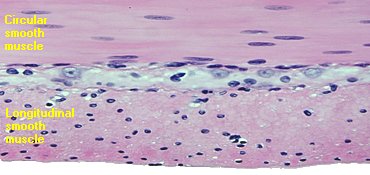VIVO Pathophysiology
The Enteric Nervous System
The nervous system exerts a profound influence on all digestive processes, namely motility, ion transport associated with secretion and absorption, and gastrointestinal blood flow. Some of this control emanates from connections between the digestive system and central nervous system, but just as importantly, the digestive system is endowed with its own, local nervous system referred to as the enteric or intrinsic nervous system. The magnitude and complexity of the enteric nervous system is immense - it contains as many neurons as the spinal cord.
The enteric nervous system, along with the sympathetic and parasympathetic nervous systems, constitute the autonomic nervous system.
The principal components of the enteric nervous system are two networks or plexuses of neurons, both of which are embedded in the wall of the digestive tract and extend from esophagus to anus:
- The myenteric plexus is located between the longitudinal and circular layers of muscle in the tunica muscularis and, appropriately, exerts control primarily over digestive tract motility.
- The submucous plexus, as its name implies, is buried in the submucosa. Its principal role is in sensing the environment within the lumen, regulating gastrointestinal blood flow and controlling epithelial cell function. In regions where these functions are minimal, such as the esophagus, the submucous plexus is sparse and may actually be missing in sections.

The image below shows part of the myenteric plexus in a section of cat duodenum. Pass your mouse cursor over the image to outline several enteric neurons.

In addition to the two major enteric nerve plexuses, there are minor plexuses beneath the serosa, within the circular smooth muscle and in the mucosa.
Within enteric plexuses are three types of neurons, most of which are multipolar:
- Sensory neurons receive information from sensory receptors in the mucosa and muscle. At least five different sensory receptors have been identified in the mucosa, which respond to mechanical, thermal, osmotic and chemical stimuli. Chemoreceptors sensitive to acid, glucose and amino acids have been demonstrated which, in essence, allows "tasting" of lumenal contents. Sensory receptors in muscle respond to stretch and tension. Collectively, enteric sensory neurons compile a comprehensive battery of information on gut contents and the state of the gastrointestinal wall.
- Motor neurons within the enteric plexuses control gastrointestinal motility and secretion, and possibly absorption. In performing these functions, motor neurons act directly on a large number of effector cells, including smooth muscle, secretory cells (chief, parietal, mucous, enterocytes, pancreatic exocrine cells) and gastrointestinal endocrine cells.
- Interneurons are largely responsible for integrating information from sensory neurons and providing it to ("programming") enteric motor neurons.
Enteric neurons secrete an intimidating array of neurotransmitters. One major neurotransmitter produced by enteric neurons is acetylcholine. In general, neurons that secrete acetylcholine are excitatory, stimulating smooth muscle contraction, increases in intestinal secretions, release of enteric hormones and dilation of blood vessels. Norepinephrine is also used extensively for neurotransmission in the gastrointestinal tract, but it derives from extrinsic sympathetic neurons; the effect of norepinephrine is almost always inhibitory and opposite that of acetylcholine.
The enteric nervous system can and does function autonomously, but normal digestive function requires communication links between this intrinsic system and the central nervous system. These links take the form of parasympathetic and sympathetic fibers that connect either the central and enteric nervous systems or connect the central nervous system directly with the digestive tract. Through these cross connections, the gut can provide sensory information to the CNS, and the CNS can affect gastrointestinal function. Connection to the central nervous system also means that signals from outside of the digestive system can be relayed to the digestive system: for instance, the sight of appealing food stimulates secretion in the stomach.
In general, sympathetic stimulation causes inhibition of gastrointestinal secretion and motor activity, and contraction of gastrointestinal sphincters and blood vessels. Conversely, parasympathetic stimuli typically stimulate these digestive activities. Some of the prominent communiques enabled by nervous interconnections within the digestive tract have been named as reflexes and serve to illustrate a robust system of control. Examples include the gastrocolic reflex, where distention of the stomach stimulates evacuation of the colon, and the enterogastric reflex, in which distention and irritation of the small intestine results in suppression of secretion and motor activity in the stomach.
Congenital and acquired derangements in the structure or function of the enteric nervous system are well recognized as causes of digestive tract disease. Examples include small intestinal motility disorders, gastric outlet obstructions and megacolon.
Send comments to Richard.Bowen@colostate.edu
An Albanian translation of this page was created by Sarah and Ermira McMason and is available at Albanian translation
An Azerbaijani translation of this page was created by Qalina Najafova at Directory.net and is available at Azerbaijani translation
A Czech translation of this page was created by Alex Navid and is available at Czech translation
A Finnish translation of this page by Elsa Jansson is available at Finnish translation
A Kazakh translation of this page by Alana Kerimova is available at Kazakh translation
A Macedonian translation of this page by Katerina Nestiv is available at Macedonian translation
A Russian translation of this page was created by Olha Fiodorova and is available at Russian translation
A Spanish translation of this page was created by Marta Mora and is available at Spanish translation
A Ukrainian translation of this page was created by Olena Chervona and is available at Ukrainian translation

